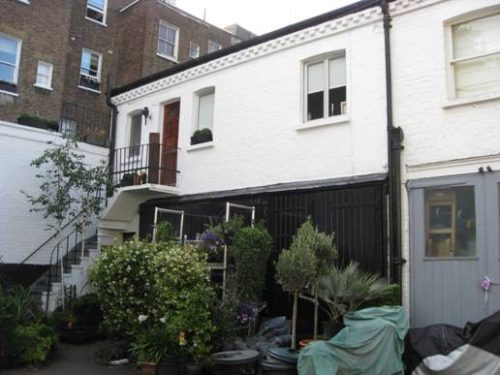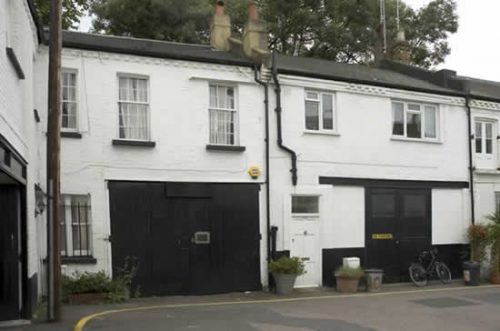Keeping the Ladbroke area special
Codrington Mews
This attractive L-shaped mews lies off Blenheim Crescent between Kensington Park Road and Ladbroke Grove.
History
Codrington Mews was built in the 1860s. There is a plan in Kensington Central Library dating from around 1864 which shows it half built. Originally, there was a way through from the mews to Ladbroke Grove, into which it emerged through a gap between Nos. 82 and 84 Ladbroke Grove. A full height extra bay was built between these houses sometime before the Ordnance Survey map of 1893, blocking the entrance and turning the mews into a dead end entered only from Blenheim Crescent.

Plan of Codrington Mews when half-built c. 1864. St Columb’s Road is the old name for Blenheim Crescent and Ladbroke Road is Ladbroke Grove.
Architecture
The mews was built to a clearly planned design with matching buildings. They all have two stories and would have had stabling below and accommodation above. In the Times of 24 December1897, for instance, No. 8 Codrington Mews was advertised to let and described as ‘containing two stalls, loose box, double coach-house, harness room, and three rooms over’. The buildings are built of London stock brick with pitched roofs and decorative brickwork under the eaves. They have been much altered over the years, but those on the north side originally had almost certainly a double stable or stable and coach house below, and external stairs up to a door on the first floor, where there would have been accommodation for coachmen etc. This pattern survives only on No. 6 at the far end.

5 Codrington Mews showing the external stair up to the first floor level.
On the south side, the pattern seems to have been slightly different, with a central doorway and an internal stair up to the first floor.
Now, all of the brickwork has been painted over, and the stables have been converted either into garages or into residential accommodation. Exceptionally, none of the houses has dormers, and this makes for an attractive roofline which it would be a great pity to spoil.
No. 11 was completely rebuilt in about 2009 in a slightly bijou style, but sufficiently similar to the neighbouring properties not to violate the character of the mews.

11 Codrington Mews (in the corner) before the rebuilding. In 1921, it was a garage and in the Times of 18 April of that year Mr Turner of 11 Codrington Mews was offering for sale a ‘Talbot, 1920 … Four seater. All weather coupé body by Cunard. Luxuriously upholstered.’

11 Codrington Mews in 2012. Note that it is the only house to retain its decorative buttress at the base of the chimney stack; and that No. 10 to the right is missing some of its decorative guttae under the eaves.
The corner building at No. 1 has for some years been the headquarters of XL, the UK’s largest independent record label, and has been decorated with artwork from its albums – the album cover from Coexist by the indie pop band The XX on the left, and artwork from the solo album The Eraser by Thom Yorke of Radiohead.


Listings and designations There are no listings or designations applying to houses or any other features in the Mews. |
Recommendations to planners, highway authority and householders Roofline: this is one of the rare mews that has kept its original rooflines and as such is a valuable asset. We urge that any applications for dormer floors should be resisted, although velux windows flush with the current roofs would be acceptable. Brickwork and painting: the houses were originally bare brick, but all have now been painted white to pleasing effect, with black drainpipes. We recommend that householders continue to keep this colour scheme. Doors and windows: We would be interested in views on whether to recommend an Article 4 Direction to require planning permission if householders wish to make changes to their doors or windows. As No. 5 in particular is in or near to its original form, it would seem well worth preserving as an example of what the houses in the Mews used to look like. Missing features: It would be welcome if one day the missing guttae under the eaves of No. 10 (see photo above) could be replaced. |
This page was last updated on 18.5.2017
